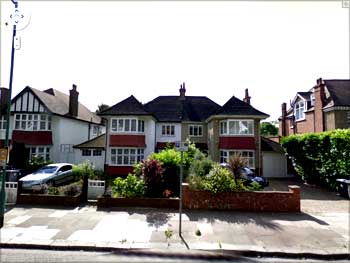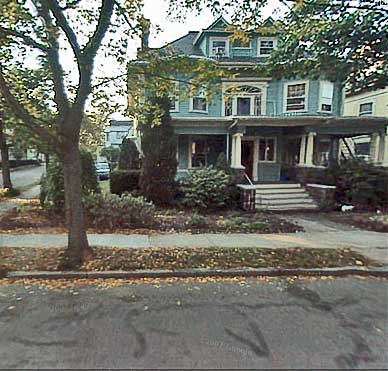No, Not the House of Commons and the House of Representatives.
There is a quality even meaner than outright ugliness or disorder, and this meaner quality is the dishonest mask of pretended order, achieved by ignoring or suppressing the real order that is struggling to exist and to be served.
Jane Jacobs.
Sometimes it is better not to keep a promise, but I said this little series would have four parts and for parts it shall have. So far, in my account of unintended consequences of progressive political reforms of a century or so ago, I've taken a look at ballot reforms like the Secret Ballot, Initiative, Referendum, and Recall, and the direct election of Senators. Let me close with something completely different-zoning and city planning ordinances, which date from about 1916. Let me begin with some visual aids and a question. Here are two houses, built roughly the same time. Both were built for the same upper middle social class-houses to be operated by the family without live-in help.


Here is the question: Which is the American house and how can you tell?
There are, of course,
lots of differences, but the one to which I'd like to draw attention is that the upper house, which is from Maida Vale, part of Greater London is a
double house, while the lower, is a
single house, is in the North Brookline neighborhood, part of Greater Boston. You'll have to take my word for it that the
individual units in the double house are roughly the size of the Brookline single-what the unit lacks in breadth it makes up for in depth. The garages in Maida Vale are add-ons, as well. In back, are gardens--modest by our exurban standards, but large enough to enjoy an evening's calm and with ample puttering space. As you can perhaps tell, each half of the double house is individually owned, and the owners have made their own decisions as what to do about matters like painting. How odd...yet it isn't odd at all in the English context.
One finds these double houses all over England: indeed, all over Western Europe. One finds them in American cities of the 19th century as well: and not just in cities. We have a handful of them in my town, dating to the early 19th century. We also have triple deckers dating to the same period-an easy walk to the factories constructed about the same time.
Briefly put:
Traditional zoning has [recently] proven less than popular in many cities. Zoning typically segregates land uses into three main categories - residential, commercial, and industrial. Thus, if a section of a city is zoned residential, then no commercial uses are allowed in the area so a grocery store cannot be built within a housing area. While zoning has served to protect property values and has enhanced the use of the automobile, it has created less than appealing cities.
Zoning: Residential, Commercial, or Industrial? By Matt Rosenberg, About.com
I won't bore you with all the details, but zoning regulations go beyond this simple three part division; establishing among other things, criteria for number of units of occupancy, number of unrelated persons living together, minimum lot size, and maximum "footprint" of the property on the lot.
New York City's discussion of Zoning, from its earliest comprehensive plan to today, is very good. I recommend clicking through to it.
As was the case with other political reforms of this era, city planning and its tools were created with the best of intentions. But as was the case so often, the best intentions were those of a specific class of reformers. In this instance, economic interests (of course) allied with aesthetic interests (
The City Beautiful Movement), to create a specific vision of what a city should look like and how it should "work". While I don't think anyone would argue for the creation of a
City Ugly Movement, the idea of beauty being in the eye of the beholder may apply here.
Regardless...good intentions do go awry. It would be fairly easy to defend any of these propositions, and I shall, if anyone wants me to:
- Zoning practices have led to far greater economic segregation than would have been the case otherwise, and economic segregation will be far harder to eradicate than racial segregation.
- Economic segregation has had baleful social consequences, not the least of which are a lack of cross/class empathy and educational inequality.
- Zoning has increased reliance on the automobile and increased the carbon footprint of American Urban areas...it aids and abets global warming.
- Zoning makes communities less resilient in times of economic disturbance. If one's economic circumstances change and one finds one's self unable to support the lifestyle of an upper class suburb, one can't remain in the community-everyone is upper class, to move to cheaper digs means leaving one's community and one's social institutions-churches, schools, and the like.
- Urban sprawl now occupies some of the most fertile farmland in the United States, especially east of the Mississippi. Cities developed where they did for two primary reasons-water for transportation and arable croplands.
Et Cetera, Et Cetera. Anyhow, reformers today are working to reverse some of byproducts of zoning ideas of one hundred years ago. Disciples of
Jane Jacobs (who was
anathema to planners like Lewis Mumford) advocate a
New Urbanism. Paradoxically, the
new interest in liveable cities continues to displace the poor through gentrification. A yuppy/dinky city would be as uninteresting to me as contemporary suburbs are. Those of you who are interested in these ideas might want to check out
James Howard Kunstler's blog.
Thanks for your patience, and I return you to Sarah Palin or whatever else fancies your tickle.


